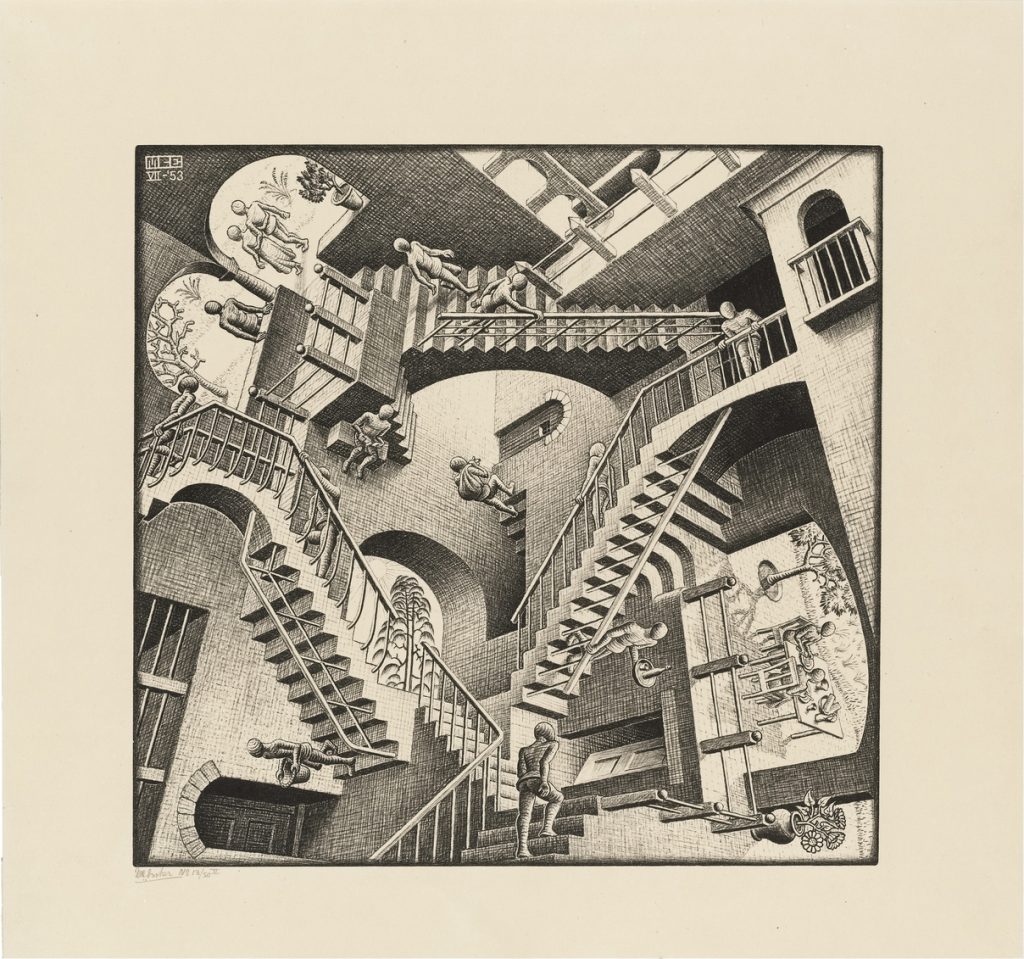(“Borges, Escher, Lovecraft” was written by the Mexican writer Guillermo Samperio and originally published in the now defunct Metapolítica [10:47 (2006): 62-63]. You can read a brief history of Metapolítica in Mónica Cruz’s 2004 review article “Metapolítica: un ejemplo a seguir.” Metapolítica, a different periodical than Metapolítica.news, was started by a group of political scientists and theorists in 1997 and later transformed into a academic and cultural magazine.)

Like Escher and Lovecraft, Borges built his own labyrinth, a place of no place, of what is and is not, an immeasurable forest, without beginning or end. Only by means of an ambush is there an encounter, an inner gaze, everything and nothing, doubt and truth, powerful doubts, painful truths.
According to Jorge Luis Borges, the literary short story obeys the precise causality of magic, since magic is the crowning moment, or the nightmare, of causality itself, not its contradiction. Howard Phillips Lovecraft stated that one of the reasons he gave his life over to writing fantastic stories was because they brought him closer to the fragmentary sensation of the marvelous.
The central concerns in the tales of Borges and Lovecraft are time and space. They turn time into a geometric figure: the labyrinth. With them, we can postulate that certain spaces are the representation of temporal states. No visual image can be fully described in words; no verbal image can be fully illustrated. However, Adriana González Mateos, in her book Borges y Escher: un doble recorrido por el laberinto [1998], discovers correspondences between Borges and Escher that go beyond mere biographical comparisons, that go beyond the denial of time and rejection of realism they share. Instead, she proposes some unusual parallels between some of their works – parallels that we also find in Lovecraft’s work.
The quest shared by Lovecraft, Borges and Escher led them to express an image of the universe in which conventional ways of understanding space have lost all validity, which allows the discovery of other, strangely juxtaposed dimensions. Without disobeying the laws of perspective, Escher creates, in his artwork “Relativity,” a disconcerting space where the notions of above and below, inside and outside, left and right are dislocated, causing the viewer to feel disoriented, aware of his own inability to comprehend what he is looking at – and perhaps even doubtful of his own spatial location. Likewise, Lovecraft describes the mythical city of R’lyeh in “The Call of Cthulhu” [1926] in the following way:
The very sun of heaven seemed distorted when viewed through the polarising miasma welling out from this sea-soaked perversion, and twisted menace and suspense lurked leeringly in those crazily elusive angles of carven rock where a second glance shewed concavity after the first shewed convexity.
For Borges, the labyrinth is a symbol of confusion and perplexity, of being lost on the journey of existence. A similar tension can be felt in both Borges and Escher’s labyrinths, namely, the anguish and the vertigo symbolized by a spacetime continuum virtually created to disorient its occupants, filled with echoes of infinity. One of Borges’s metaphors is the city of the immortals [“The Immortal”/“El inmortal,” 1947], in which architectural elements are combined without discernable order. “Such an architecture had no end” and gives the impression of “interminability,” of the “atrocious,” the “intricately insane,” until an anguished conclusion takes shape: “The gods who built the city were mad.”
Borges, Escher, and Lovecraft all favored an abstract representation built more with archetypes, concepts, or generic images than with concrete particulars. Borges himself was interested in the Kabbalah, a mystical current of thought according to which the universe is the result of the combination of the letters of the Hebrew alphabet. Lovecraft was interested in primitive, chiefly Gnostic, mythologies, according to which the universe was created by demons or by some deficient demiurge. As for Escher, his work is a continuation of the arabesque, an abstract form of art created by Islamic artists that prohibits the representation of images imitating nature.
Borges and Lovecraft, then, are ironists – or, as Borges expresses it in his story “The Aleph” [“El aleph,” 1945]: “Once again, I show my awareness that truly modern art demands the balm of laughter, of scherzo.” Similarly, Lovecraft was actually a materialist author who scoffed at his blasphemous entities, and who was able to use them to parody the petty parochialism of the world. These two storytellers questioned the machinery of perception that leads us to give far too much credit to that which calls itself “reality.”
~
Thanks to Iker Garcia and Daniel Guzman for feedback on the translation. Garcia adds the following comment, with which I completely agree: “Samperio’s quotation from ‘El Aleph’ is made by Carlos Argentino Daneri, a character the narrator (Borges) consistently, ruthlessly mocks. Some scholars say that this character is based on the well-known poet Pablo Nerudo, whom Borges disliked immensely, I guess first of all for political reasons. Hence, Samperio completely misses Borges’ irony in this passage of the story, which I have to say is otherwise glaringly and painfully obvious. Borges and his narrator put these words in the mouth of someone he despises, yet Samperio uses them to represent Borges’ own opinion! Afraid to say this blunder completely discredits Samperio as a commentator on Borges, unless I’m missing something.”